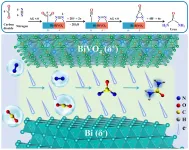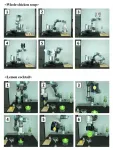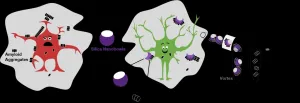Using artificial intelligence to hunt for breast cancer
The new "E-Morph" test method does not require animal testing
2021-02-26
(Press-News.org) The centre is part of the German Federal Institute for Risk Assessment (BfR). With the help of microscopy and artificial intelligence, the "E-Morph" test reliably identifies substances that can have oestrogen-like or even opposing effects, according to the research team's report in the specialist journal "Environment International". "E-Morph is a milestone on the way to, one day, replacing animal experiments currently required to detect hormone-like effects," says BfR President Prof. Dr. Dr. Andreas Hensel.
Link to the specialist publication (ScienceDirect):
https://www.sciencedirect.com/science/article/pii/S0160412021000350
Link to the article in BfR2GO, the BfR science magazine:
https://www.bfr.bund.de/cm/429/16_protection_of_laboratory_animals.pdf
The test is based on the observation that substances with an oestrogen-like effect can loosen the connection between cells in the mammary gland. This makes it easier for breast cancer cells to detach themselves from the tissue - a crucial step in the spreading (metastasis) of tumours. In the E-Morph test, a test substance is given to cultured human breast cancer cells. The cells are then examined to detect whether the cell contacts loosen as if under the influence of oestrogen. This effect is easy to observe under the microscope and can be evaluated fully automated using artificial intelligence. The robot-assisted test including evaluation is quick and enables many substances to be tested in short time. Potential future uses of the test include testing chemicals that have already been marketed as well as those that are about to be launched. The test can also be used to develop new drugs, improve diagnostic tests to detect breast cancer, and optimise therapies.
INFORMATION:
About the BfR
The German Federal Institute for Risk Assessment (BfR) is a scientifically independent institution within the portfolio of the Federal Ministry of Food and Agriculture (BMEL) in Germany. It advises the German federal government and German federal states ("Laender") on questions of food, chemical and product safety. The BfR conducts its own research on topics that are closely linked to its assessment tasks.
About Bf3R
The German Centre for the Protection of Laboratory Animals (Bf3R) was founded in 2015 and is an integral part of the German Federal Institute for Risk Assessment (BfR). It co-ordinates all activities nationwide with the goals of restricting animal experiments to only those which are considered essential, and guaranteeing the best possible protection for laboratory animals. Moreover, it intends to stimulate research activities and encourage scientific dialogue.
This text version is a translation of the original German text which is the only legally binding version.
ELSE PRESS RELEASES FROM THIS DATE:
2021-02-26
A number of brain areas change their activity before we execute a planned voluntary movement. A new study by Umeå University identifies a novel function of this preparatory neural activity, highlighting another mechanism the nervous system can use to achieve its goals.
Voluntary movements are prepared before they are executed. For example, such 'preparation' occurs in the period between seeing a coffee cup and starting to reach for it. Neurons in many areas of the brain change their activity during movement preparation in ways that reflect different aspects of ...
2021-02-26
Eminent scientists warn that key ecosystems around Australia and Antarctica are collapsing, and propose a three-step framework to combat irreversible global damage.
Their report, authored by 38 Australian, UK and US scientists from universities and government agencies, is published today in the international journal Global Change Biology. Researchers say I heralds a stark warning for ecosystem collapse worldwide, if action if not taken urgently.
Lead author, Dr Dana Bergstrom from the Australian Antarctic Division, said that the project emerged from a conference inspired by her ecological research in polar environments.
"I was seeing unbelievably rapid, widespread dieback in the alpine tundra of World Heritage-listed Macquarie Island and started wondering if this ...
2021-02-26
Converting both nitrogen (N2) and carbon dioxide (CO2) into value-added urea molecules via C-N coupling reaction is a promising method to solve the problem of excessive CO2 emissions.
Compared with huge energy consumption industrial processes, the electrochemical urea synthesis provides an appealing route under mild conditions. However, it still faces challenges of low catalytic activity and selectivity.
A research team led by Prof. ZHANG Guangjin from the Institute of Process Engineering (IPE) of the Chinese Academy of Sciences fabricated Bi-BiVO4 Mott-Schottky heterostructure catalysts for efficient urea synthesis at ambient conditions.
This work was published in Angewandte Chemie International ...
2021-02-26
The Korea Institute of Machinery and Materials (KIMM) successfully developed all-round gripper* technology, enabling robots to hold objects of various shapes and stiffnesses. With the new technology, a single gripper can be used to handle different objects such as screwdrivers, bulbs, and coffee pots, and even food with delicate surfaces such as tofu, strawberries, and raw chicken. It is expected to expand applications in contact-free services such as household chores, cooking, serving, packaging, and manufacturing.
*Gripper: A device that enables robots to hold and handle objects, ...
2021-02-26
Memphis, Tenn. (February 25, 2021) - Early diagnosis of Alzheimer's disease has been shown to reduce cost and improve patient outcomes, but current diagnostic approaches can be invasive and costly. A recent study, published in the Journal of Alzheimer's Disease, has found a novel way to identify a high potential for developing Alzheimer's disease before symptoms occur.
Ray Romano, PhD, RN, completed the research as part of his PhD in the Nursing Science Program at the University of Tennessee Health Science Center College of Graduate Health Sciences. Dr. Romano conducted the research through the joint laboratory of Associate ...
2021-02-26
DETROIT (February 25, 2021) - Researchers at Henry Ford Health System, as part of a national asthma collaborative, have identified a gene variant associated with childhood asthma that underscores the importance of including diverse patient populations in research studies.
The study is published in the print version of the American Journal of Respiratory and Critical Care Medicine.
For 14 years researchers have known that a casual variant for early onset asthma resides on chromosome 17, which holds one of the most highly replicated and significant genetic associations with asthma. Henry Ford researchers acknowledged they would not have identified it in this study ...
2021-02-26
ROCKVILLE, MD - Scientists are still a long way from being able to treat Alzheimer's Disease, in part because the protein aggregates that can become brain plaques, a hallmark of the disease, are hard to study. The plaques are caused by the amyloid beta protein, which gets misshapen and tangled in the brain. To study these protein aggregates in tissue samples, researchers often have to use techniques that can further disrupt them, making it difficult to figure out what's going on. But new research by Vrinda Sant, a graduate student, and Madhura Som, a recent PhD graduate, in the lab of Ratnesh Lal at the University of California, San Diego, provides a new technique for studying amyloid beta and could be useful in future Alzheimer's treatments. Sant and her colleagues will present their research ...
2021-02-26
Our use of social media, specifically our efforts to maximize "likes," follows a pattern of "reward learning," concludes a new study by an international team of scientists. Its findings, which appear in the journal Nature Communications, reveal parallels with the behavior of animals, such as rats, in seeking food rewards.
"These results establish that social media engagement follows basic, cross-species principles of reward learning," explains David Amodio, a professor at New York University and the University of Amsterdam and one of the paper's authors. "These findings may help us understand why social media comes to dominate daily life for many people and provide clues, borrowed from research on reward learning and addiction, to how troubling online engagement may ...
2021-02-26
Chemical engineering researchers have developed a new catalyst that significantly increases yield in styrene manufacturing, while simultaneously reducing energy use and greenhouse gas emissions.
"Styrene is a synthetic chemical that is used to make a variety of plastics, resins and other materials," says Fanxing Li, corresponding author of the work and Alcoa Professor of Chemical Engineering at North Carolina State University. "Because it is in such widespread use, we are pleased that we could develop a technology that is cost effective and will reduce the environmental impact of styrene manufacturing." Industry estimates ...
2021-02-26
The koala retrovirus (KoRV) is a virus which, like other retroviruses such as HIV, inserts itself into the DNA of an infected cell. At some point in the past 50,000 years, KoRV has infected the egg or sperm cells of koalas, leading to offspring that carry the retrovirus in every cell in their body. The entire koala population of Queensland and New South Wales in Australia now carry copies of KoRV in their genome. All animals, including humans, have gone through similar "germ line" infections by retroviruses at some point in their evolutionary history and contain many ancient retroviruses in their genomes. These retroviruses have, over millions of years, mutated into degraded, inactive forms that are no longer harmful to the host. Since in most animal ...
LAST 30 PRESS RELEASES:
[Press-News.org] Using artificial intelligence to hunt for breast cancer
The new "E-Morph" test method does not require animal testing






